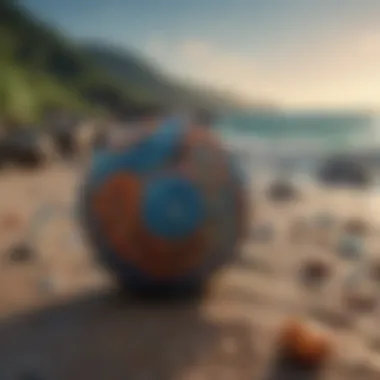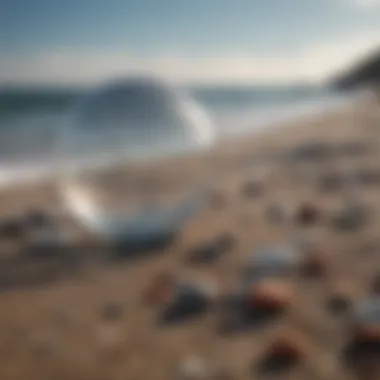Transforming Ocean Plastic into Beautiful Beads


Nature Topic Overview
Plastic pollution remains a significant threat to our oceans and has far-reaching effects on marine ecosystems. Among the most innovative solutions emerging from this crisis is the creation of beads made from ocean plastic. This article delves into how discarded plastic is transformed into these unique beads, exploring the entire process from collection to production. Understanding this topic is crucial for the younger generation, as it serves as a gateway to comprehend the broader implications of environmental conservation and sustainability.
Plastic waste, especially in ocean environments, is not just an eyesore; it disrupts marine life and pollutes coastlines. The production of beads from ocean plastic can help mitigate these effects by offering an alternative use for materials that would otherwise contribute to ecological decay.
Fun Facts and Trivia
Did you know that:
- Over 8 million tons of plastic winds up in the ocean every year?
- Sea turtles often mistake plastic bags for jellyfish, leading to harmful consequences?
- Beads made from recycled ocean plastic can be used to create beautiful jewelry and art?
These facts highlight both the problem and the potential solutions available. Consider enhancing this learning experience through visual aids or interactive projects that can reinforce these concepts.
Wildlife Explorations
The oceans are home to a diverse array of species, many of which are adversely affected by plastic pollution. Here are a few examples:
- Sea Turtles: These remarkable creatures often ingest plastic debris, mistaking it for food.
- Coral Reefs: Microplastics can harm the microscopic algae that corals rely on, jeopardizing entire ecosystems.
- Fish Species: Fish can consume microplastics, which then enter the food chain, affecting predators including humans.
Engaging kids with quizzes or puzzles about these animals can enhance their understanding of relatable environmental issues.
Environmental Awareness
Beads made from ocean plastic are not just a craft item; they embody a lesson in sustainability. Teaching children about the significance of conserving our oceans can drive meaningful action. Young people can:
- Participate in local beach clean-ups to help remove plastic waste.
- Reduce their use of single-use plastics by opting for reusable products.
- Educate others about the impact of plastic on marine life.
Awareness of these simple actions lays the foundation for a more sustainable future.
DIY Nature Activities
Encouraging hands-on activities can foster a sense of responsibility towards the environment. Here are some activities kids can try:
- Ocean Plastic Art: Collect small plastic items and create a mural or sculpture.
- Jewelry Making: Use beads made from ocean plastic to create bracelets or necklaces.
- Nature Walks: Explore local parks or beaches, observing how litter impacts the environment.
Providing detailed guides on these projects can make them more accessible and promote a love for nature and creativity.
Prelude to Ocean Plastic
Plastic pollution in the oceans is an increasingly critical issue that impacts both marine life and human health. The introduction of ocean plastic into this discourse serves several important functions. First, it raises awareness about the sheer quantity of plastic waste that ends up in our oceans. Millions of tons of plastic are discarded every year, threatening marine ecosystems and wildlife.
The conversion of this plastic waste into products like beads not only provides an innovative solution but also highlights the potential for recycling and reusing materials that would otherwise pollute oceans. By understanding ocean plastic, we can better appreciate the benefits of reducing waste, conserving resources, and promoting sustainability.
Understanding Ocean Pollution
Ocean pollution refers to the introduction of harmful substances into the aquatic environment. This contamination can come from numerous sources, including urban runoff, littering, industrial activity, and improper waste disposal. Plastic waste is particularly troublesome because it does not decompose naturally and can remain in the water for hundreds of years.
Many forms of ocean plastic can be identified:
- Microplastics: Tiny plastic particles less than 5mm in size, often resulting from the breakdown of larger items.
- Plastic bottles: Commonly used items that are frequently discarded and contribute heavily to ocean waste.
- Fishing gear: Abandoned nets and lines can entangle marine animals, leading to injury or death.
These types of pollution not only harm marine creatures but disturb entire ecosystems. The reduction and proper management of these pollutants can lead to healthier oceans.
The Origins of Ocean Plastic
The origins of ocean plastic stem from various human activities. Understanding these sources is fundamental to tackling the problem effectively. Plastic items are often used only once and carelessly discarded. The following key points outline how plastic waste ends up in the ocean:
- Littering: Many individuals do not dispose of plastic waste properly, allowing it to be washed away into waterways and, ultimately, the ocean.
- Industrial Discharges: Factories may inadvertently release plastic waste into local rivers and lakes.
- Stormwater Runoff: Rain can wash litter from streets and land into storm drains, which can lead directly to the sea.
Additionally, natural disasters like floods can exacerbate the situation, lifting large amounts of plastic waste into our oceans. Recognising these origins helps in the formulation of laws and practices that curb plastic waste before it can reach aquatic environments.


The insights about ocean plastic provide a foundation for examining the subsequent sections of the article. By exploring how to collect and transform this waste into beads, we can appreciate a circular economy that benefits both the environment and communities.
The Process of Making Beads from Ocean Plastic
The process of making beads from ocean plastic is essential for understanding how discarded materials can be transformed into valuable products. This not only underscores the potential of recycling but also plays a significant role in addressing the larger issue of plastic pollution in our oceans. By exploring this process, we can highlight the importance of repurposing waste for sustainability. Moreover, this process involves several stages, each critical to ensuring the final product is safe and reliable.
Collection of Ocean Plastic
Collecting ocean plastic is the first step in the production of beads. This can occur in several ways, often involving volunteers and organizations dedicated to marine conservation. Beach clean-ups are one common method where individuals gather plastics and other debris washed ashore. Specialized boats and crews also search polluted areas in oceans and rivers to gather larger pieces of plastic. Each piece collected contributes to reducing pollution and creating a sustainable product.
This collection process serves dual purposes: it cleans the environment and provides raw materials for bead manufacturing. It's important that people understand their role in this effort. With each clean-up, they can see firsthand how much plastic ends up in our oceans.
Sorting and Cleaning
Once collected, the next phase is sorting and cleaning the ocean plastic. This part is critical because not all plastic collected is suitable for bead production. Sorting involves separating plastics by type and color. Different plastics have different properties and recycling processes, so it’s crucial to ensure only compatible materials are used.
After sorting, the plastic goes through a thorough cleaning process. This may involve rinsing and washing to remove saltwater, mud, and any organisms that may have attached themselves. Clean plastic is more effective in manufacturing beads since impurities can lead to defects. In this way, the sorting and cleaning steps ensure the quality of the final product, which is vital for both aesthetic and functional reasons.
Manufacturing Techniques
Manufacturing beads from ocean plastic requires specific techniques. After cleaning, the sorted plastic is often shredded into small pieces to facilitate melting and molding. Following this, the pieces are melted at a controlled temperature and can be poured into molds to create beads of various shapes and sizes.
There are also methods like extrusion, where melted plastic is forced through a die to make long strands that can be cut into beads. It's essential during manufacturing to maintain quality. Temperatures and times must be precise to ensure consistency in the materials.
This section of the process not only showcases technological advancements in recycling but also opens up opportunities for creativity. Each bead can carry a story, linking back to its origins in the ocean. Such techniques are at the heart of what makes ocean plastic beads unique.
Collectively, these steps in the manufacturing process illustrate how discarded materials can be transformed into beautiful and functional items. By turning ocean plastic into beads, we contribute to environmental solutions while encouraging creativity and innovation.
Applications of Ocean Plastic Beads
The applications of ocean plastic beads are diverse and important. They serve not only as a creative outlet for artists but also significantly contribute to sustainability. The creative adoption of these beads in various sectors demonstrates how they can be a solution in reducing plastic waste. Moreover, they represent a shift towards responsible consumption and supporting environmental initiatives. In this section, we explore three key areas where ocean plastic beads are making an impact: fashion and jewelry, art and craft projects, and educational tools.
Fashion and Jewelry
Ocean plastic beads are finding their way into the fashion industry. Designers are now using these beads in clothing, accessories, and jewelry. This adds an innovative touch to fashion while addressing environmental issues. Items made with ocean plastic not only look unique but also tell an important story about sustainability. It’s a chance for consumers to express themselves while supporting the health of our oceans. By wearing or using these products, people contribute to the fight against plastic pollution.
Some popular examples include bracelets made from colorful ocean plastic beads or necklaces that feature unique designs. These items are often appealing to young audiences, making them perfect for gifts or personal expression. By purchasing such products, individuals can contribute to the market for sustainable fashion, ensuring a higher demand for ocean-friendly materials.
Art and Craft Projects
Another significant application of ocean plastic beads is in art and craft projects. These beads provide an excellent medium for creativity, as they come in various colors and sizes. Artists and hobbyists can use them to make beautiful creations. From decorative items to educational projects, the uses are endless. Using ocean plastic beads in crafts allows everyone, including children, to participate in reducing waste while being creative.
For example, schools can introduce craft sessions where students create items using these beads. This practice helps increase awareness of plastic pollution and promotes teamwork among students. Not only does this inspire creativity, but it also teaches valuable lessons about recycling and sustainability.
Educational Tools
Educational tools are also a key area for ocean plastic beads. They can be used to teach children about environmental responsibility and plastic pollution. Schools and parents can incorporate these beads into curriculums, using them as teaching aids for discussions about ocean health and recycling.
For instance, ocean plastic beads can be used in science projects to visually represent the amount of plastic in oceans. Students can create models or charts to illustrate this issue. This active engagement helps reinforce their learning in a fun and meaningful way.
"By integrating ocean plastic beads into educational practices, we prepare future generations to be stewards of our environment."
In summary, the applications of ocean plastic beads are impactful and promote sustainability. They extend beyond just a product; they represent a movement towards environmentally conscious choices in fashion, arts, and education.
Environmental Impact of Ocean Plastic Beads
Understanding the environmental impact of ocean plastic beads is crucial for recognizing their significance in addressing plastic pollution. Ocean plastic beads made from recovered materials offer not only a new life for discarded plastics, but also an opportunity to raise awareness about environmental issues. These beads contribute to both reducing overall waste and supporting broader ecological initiatives.
Reducing Plastic Waste
One of the most critical aspects of using ocean plastic in bead production is the role it plays in reducing plastic waste. Each year, millions of tons of plastic enter oceans, causing various forms of harm to marine life. By collecting this plastic and repurposing it into beads, we create a closed-loop system. This means we can take something harmful and transform it into something valuable.


The production of ocean plastic beads can help reduce the overall demand for virgin plastic materials, which are derived from fossil fuels. This transition is vital because it can help:
- Decrease landfill overflow: Every plastic bead made from ocean waste is one less piece of plastic consuming space in landfills.
- Minimize marine pollution: When we recycle plastics from the ocean, we reduce the chances of these materials contributing to marine pollution in the future.
- Lower carbon footprint: Utilizing recycled materials often requires less energy compared to producing new plastics, further aiding in reducing carbon emissions.
The transformation of ocean plastic into beads highlights how waste materials can be repurposed for new uses. This initiative promotes a sustainable lifestyle, emphasizing the importance of reducing plastic consumption and increasing recycling efforts.
Promoting Marine Conservation
Another significant benefit of ocean plastic beads is their contribution to marine conservation. Creating awareness around this issue can stir a sense of responsibility among consumers and manufacturers alike.
Using discarded ocean plastic helps in several key ways:
- Support for clean-up efforts: The production of ocean plastic beads often comes alongside beach clean-up events. These collaborative efforts not only remove plastic from the ocean but also involve community participation, fostering a stronger connection to ocean health.
- Education and awareness: By showcasing the story of ocean plastic beads, we can educate broader audiences on the impacts of pollution. Knowing where materials come from encourages people to think critically about their own consumption habits.
- Funding conservation initiatives: Some brands that create ocean plastic beads contribute a portion of their profits to marine conservation projects. This creates a cycle where profit leads to positive environmental impact.
Utilizing ocean plastic beads is more than just a practical solution to waste; it embodies a commitment to protecting marine ecosystems. Increasing popularity can drive demand for sustainable practices in various sectors, ultimately benefiting the oceans.
"We can take something harmful and transform it into something valuable."
Challenges in Utilizing Ocean Plastic
Utilizing ocean plastic for creating beads presents various challenges that need addressing. First, the quality of ocean plastic is highly inconsistent. Plastic materials retrieved from the ocean can vary significantly in type and condition. This results in issues related to quality control, which is essential for producing high-quality beads. Without rigorous quality assurance, the final products may not meet the expectations for durability or aesthetics. This inconsistency can impede the overall acceptance of ocean plastic products in the market.
Second, there exists a significant gap in public awareness regarding this issue. Many people do not understand the impact of ocean pollution or the benefits of using ocean plastic. This lack of awareness can hinder demand for products made from ocean plastic. Educating the public is crucial to encourage the adoption of these innovative materials. Only when people recognize the importance of ocean plastic utilization can the market for these beads expand.
In summary, addressing quality control issues and raising public awareness are critical components in overcoming challenges associated with using ocean plastic for bead production. Both elements require concerted efforts from manufacturers, environmental organizations, and educators to foster a sustainable future.
Quality Control Issues
Quality control is a pressing challenge when turning ocean plastic into usable beads. The collection methods vary and might include a mix of plastics such as polyethylene, polypropylene, and polystyrene. Each type has different properties and requires specific treatment during the manufacturing process. If not managed properly, poor-quality plastic can affect the bead's durability and safety.
Additionally, earlier processing steps, like sorting and cleaning, must be done meticulously. Any remnants of organic matter or other materials can lead to compromised products. It adds complexity to the manufacturing process and increases production costs. Therefore, manufacturers must establish strict quality control protocols.
Public Awareness Gaps
Public awareness gaps present a significant obstacle in the utilization of ocean plastic. Many people are still unaware of how plastics from the oceans can be recycled into innovative products like beads. Educating the general population about ocean pollution is critical. Without awareness, consumers may not see the value in purchasing items made from ocean plastic. This can lead to lower market interest and, consequently, fewer resources directed towards ocean clean-up and recycling efforts.
Various strategies can help bridge this gap. Schools and community programs can offer educational programs that discuss the impact of plastic pollution and the benefits of using alternatives. Social media campaigns could reach a broader audience by sharing stories and success about ocean plastic projects.
By raising awareness, the marketplace can foster greater demand for ocean plastic beads. This can ultimately lead to innovations in manufacturing and environmental sustainability.
The Role of Education in Plastic Pollution Mitigation
Education serves as a cornerstone in tackling the issue of plastic pollution in oceans. By informing young minds about environmental challenges and solutions, we inspire a generation that is knowledgeable and responsible. This article emphasizes the significance of educational initiatives in fostering awareness around ocean plastic.
Teaching children about the impact of plastic pollution cultivates critical thinking; they learn not only about the problems but also about ways to contribute positively. Programs can encourage creativity in addressing these issues, by developing solutions using ocean plastic. Furthermore, education promotes understanding of how individual actions can lead to large-scale environmental change.
> "Education is the most powerful weapon which you can use to change the world." – Nelson Mandela
Educational Programs for Children
Educational programs tailored for children are essential. They can take various forms, such as workshops, school projects, and interactive learning experiences. By engaging with hands-on activities, children can understand more deeply impacts of their choices on the environment.
- Workshops on Recycling: These encourage children to learn how to sort waste correctly and understand what happens to materials once they leave their homes.
- Field Trips: Visiting recycling centers or local beaches can give students a first-hand look at the issues related to plastic waste and the importance of keeping oceans clean.
- Creative Projects: Using recovered ocean plastic in arts and crafts can illustrate not only the opportunity to recycle but also the value of creativity in environmental efforts.
Educational programs should convey that ocean plastic is not just a distant problem; it affects local environments. Activities that connect them to both the global and local aspects foster a sense of responsibility.
Creating Responsible Consumers
Creating responsible consumers is another key aspect of education about plastic pollution. With a strong understanding of their purchasing power, children can become advocates for sustainable products and practices.
- Understanding Brand Responsibility: Teaching kids about brands that prioritize sustainability helps direct their choices towards products made from recycled materials.
- Informed Choices: Encouraging kids to ask questions about where products come from and how they are packaged promotes critical thinking.
- Local Clean-Up Initiatives: Participating in community efforts not only helps the environment but teaches children the impact of teamwork and collaboration.


When children embody the values of responsible consumption, they create a ripple effect that influences family and peers. Their actions, informed by education, can lead to greater demand for sustainable alternatives in the marketplace.
Success Stories and Innovations
Case Studies of Ocean Plastic Projects
The journey of transforming ocean plastic into useful products has seen many successful projects making waves in environmental conservation. These case studies highlight real-world examples of how this initiative not only addresses waste but also creates meaningful change.
One notable example is the initiative by Parley for the Oceans, which collaborates with brands like Adidas to create footwear made from ocean plastic. This project not only repurposes plastic waste but also raises awareness about the pollution crisis. When people wear those shoes, they carry a message about sustainability and the oceans’ health.
Another important case is the work being done by Ocean Conservancy, an organization known for organizing coastal clean-up events worldwide. Their successes come from turning collected waste into hand-crafted goods. Artists and designers use these materials to create art pieces that communicate the story of our oceans. It helps the community engage with the issue at a deeper level, turning trash into compelling visual stories.
These projects serve as a beacon of hope and show the power of collaboration. By leveraging creativity and community involvement, the ocean plastic movement gains traction.
Innovative Uses of Ocean Plastic
As more organizations tap into the world of ocean plastic, a variety of innovative uses have emerged. Ocean plastic beads have found places in diverse fields, showcasing their versatility.
- Jewelry and Accessories: Many artists create beautiful jewelry using beads made from ocean plastic. These pieces often tell a story about ocean conservation and connect the wearers to the cause.
- Home Décor: Ocean plastic beads have become popular in home decoration. They can be turned into unique curtain weights, vases, and even furniture accents. This personalizes spaces while promoting sustainability.
- Educational Tools: Some educators are incorporating ocean plastic materials into their teaching methods. For example, using ocean plastic beads for math or science projects can help children learn about recycling and environmental impact in a practical way.
Each of these innovations not only utilizes waste but also promotes a broader understanding of plastic pollution and the importance of marine conservation.
"Using ocean plastic is a demonstration of how waste can become beautiful and functional. It challenges us to rethink what we throw away and consider its potential value."
In summary, the successes and innovations in using ocean plastics not only help to clean up environments but also inspire others. By showcasing these achievements, we encourage further efforts in sustainability and ocean conservation.
Future Perspectives on Ocean Plastic Utilization
The possibility of transforming ocean plastic into useful products, like beads, opens up several future perspectives that can significantly address environmental issues. Innovative solutions are critical as plastic pollution in oceans continues to disrupt marine ecosystems and human lives. This section blends optimism and realism, exploring how we can envision a world where ocean plastic is more than just waste, but a resource for new products and ideas.
Technological Advancements
Technology plays a key role in the utilization of ocean plastic. Innovations in recycling processes are becoming increasingly important. New methods can enhance the quality of recycled ocean plastic, making it suitable for a variety of applications. This includes advanced sorting technologies that can identify different types of plastic materials quickly and accurately.
Another aspect is the enhancement of cleaning processes. By employing effective technologies, companies can ensure that ocean plastic is thoroughly cleaned before it becomes beads. These advancements will lead to more reliable products while also mitigating health risks associated with impurities.
Furthermore, improving the durability of ocean plastic beads through technological advances in polymer science encourages sustainable use. Not only do stronger beads provide better longevity, they also reduce the frequency of needing replacements, hence minimizing waste.
"Innovative recycling technologies present a viable solution to tackling ocean plastic pollution."
Global Policy Implications
As the conversation around ocean plastic gains momentum, so does the call for supportive policies that foster sustainable practices. Governments and organizations worldwide are increasingly recognizing the necessity of implementing strict regulations on plastic production, consumption, and waste management.
International cooperation is vital. Treaties that focus on reducing plastic waste can direct funds and resources towards ocean cleanup initiatives. This global effort can create a culture that values sustainability and holds corporations accountable for their plastic footprint.
In the context of ocean plastic beads, policy implications can also include incentives for businesses that engage in responsible sourcing of ocean plastics. This regulatory support can spur economic growth while simultaneously addressing environmental issues.
Ultimately, both technological advancements and global policies will shape the future of ocean plastic utilization. By prioritizing these areas, society can develop a proactive approach to combating ocean pollution. Investing in innovative methods and robust regulatory frameworks can create a cleaner, more sustainable planet.
Closure
The conclusion of this article serves as an essential wrap-up of the significant themes discussed regarding ocean plastic beads. These beads are not just a remarkable product; they represent a critical step in addressing our global plastic problem. Their creation is not only an answer to pollution but also speaks to a larger narrative of sustainability and responsibility towards our environment.
Summarizing the Importance of Ocean Plastic Beads
Ocean plastic beads signify a bridge between waste and utility. They are made from materials that otherwise harm marine ecosystems. By transforming discarded plastic into beads for fashion or crafts, we are acknowledging the potential for circular economies. Some crucial elements include:
- Resource Recovery: By utilizing ocean plastic, we reclaim materials that would otherwise contribute to pollution.
- Awareness and Education: These beads can be educational tools, emphasizing the importance of recycling and reducing plastic use.
- Creative Solutions: They allow artists and designers to generate innovative products that highlight environmental responsibilities.
Each bead tells a story of transformation, not just of plastic but of our understanding of waste. When people see or wear these beads, they are reminded of the importance of caring for our oceans.
Encouraging Action and Awareness
To create a significant impact, it’s vital to encourage collective action. Here are some thoughts on how we can promote awareness:
- Education Programs: Schools and organizations should integrate lessons about plastic pollution and sustainability.
- Community Engagement: Local workshops can be organized to create products from ocean plastic, fostering community spirit around environmental issues.
- Social Media Campaigns: Use platforms like Facebook or Reddit to share stories and engage the public in discussions about ocean plastic.
It is essential for everyone— children, parents, and educators—to understand the role they play in reducing plastic waste. Everyone can contribute in one way or another to this global issue. By making conscious choices and spreading awareness, we can ensure that the narrative surrounding ocean plastic beads continues to be one of hope and action.







